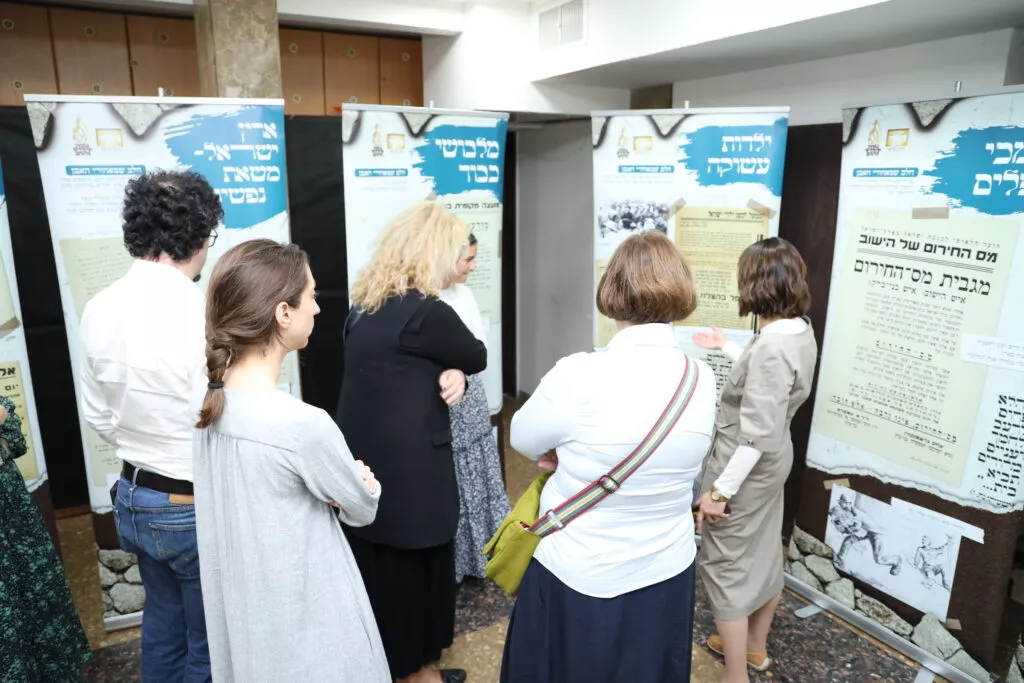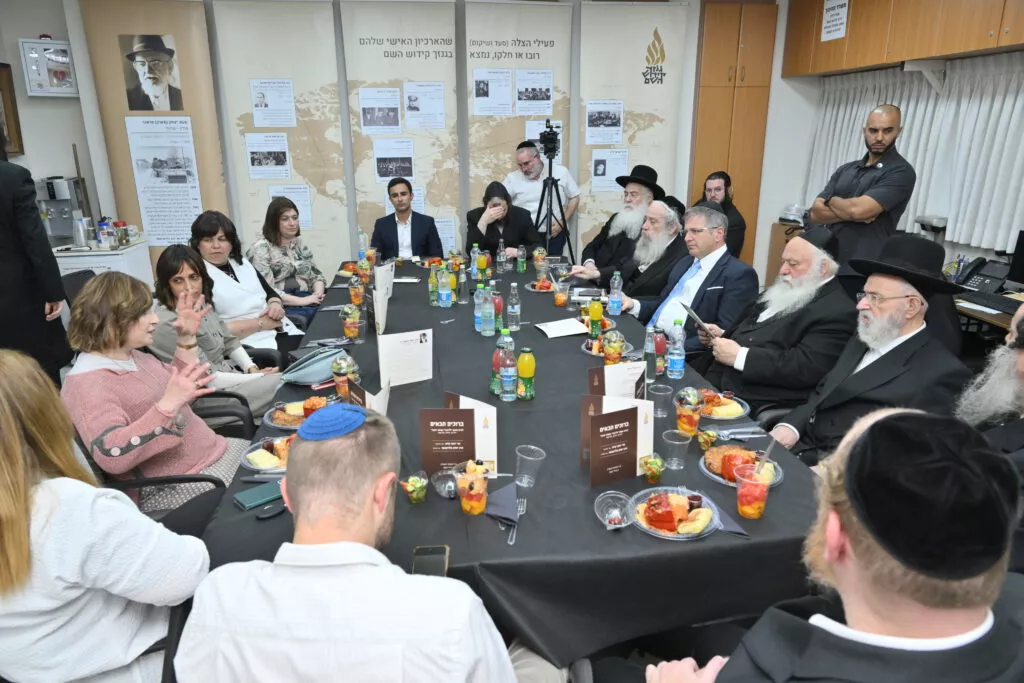The modest study rooms were packed to the point of exhaustion. People went up and down, screens flickered, documents and testimonies, books and pamphlets, archival exhibits moved from floor to floor, and downstairs in the large hall adjacent to the Ganzach Kiddush Hashem building sat one hundred and fifty yeshiva students from Ashdod, captivated by a heart-wrenching story, a story they will not hear anywhere else.
Every day, Ganzach Kiddush Hashem holds activities around the clock, but today, on the eve of 3 Weeks preceding Tisha B’Av, Ganzach held events that even here are considered extraordinary.
The morning started as usual at half past seven, with the arrival of the archive workers for a livelyand busy work day. There is not a dull moment in the archive, which is one of the greatest in the State of Israel. The materials multiply day by day, and are treated, maintained, deciphered, and documented professionally and efficiently.
The management office works feverishly. The youth programs taking place in the near future are endless, but in the end they reach everyone. The numbers are huge. One hundred and twenty thousand teenagers in the last year!
Small computer stations are covered with mountains of photos, and among them are letter decoders, editors, researchers, librarians, and writers. Their work is a sacred craft. It is a collection of valuable material for a new study kit for schools and students; it deciphers an ancient manuscript from the sea of documents in the archive, and at the corner of the library, the librarian catalogs more and more titles from the fifty thousand books in the treasure trove of Ganzach Kiddush Hashem.
In the center of the crowded room stands a heavily bearded man, a guest from Modiin Ilit, a writer and researcher by profession, and in the midst of all the activities is one of the researchers of Ganzach Kiddush Hashem who is available to provide him with courteous and professional service, advice, and guidance in a pleasant manner.
Soon, G-d willing, when the new building will be built, and all this wonderful activity will move to the large and spacious permanent residence, there is no doubt that no one will understand how they managed to juggle these activities in the current minimal conditions. Amazingly, though, the density does not at all affect the enormous growth and blossoming in all areas of Ganzach Kiddush Hashem, certainly not for the educational activities that mostly take place outside the complex, with special permission from the Ministry of Education.
At half past two in the afternoon the meeting room was filled with distinguished guests from overseas. The members of the management of the Jewish Historical Institute, the “ZIH”, which is the oldest Jewish museum located in Warsaw, came to visit Ganzach Kiddush Hashem.

The cooperation between the two bodies has already yielded great benefits for the study of Jewish strength during the Holocaust and for the study of Jewish history in Warsaw in general, and now the members of the board of the ZIH came to see with their own eyes the activities of Ganzach Kiddush Hashem and its great archive.
The Jewish museum in Warsaw contains priceless treasures; thousands of rare photos, documents, manuscripts, ancient Judaica items and the “Oneg Shabbat Archives” – the archive that was written underground during the Holocaust and which we will tell about in a special article here next week, G-d willing.
On the fourth floor on Meltzer Street, a phone call was received announcing: “The buses have arrived.”
These are the buses of yeshiva students from Ashdod who arrived for a day of study at Ganzach Kiddush Hashem.

The large hall next to Ganzach Kiddush Hashem was lit and air-conditioned. The regular spectacular and exciting exhibitions were on display. One exhibit tells about leadership during the Holocaust and from it the students learn directly about the dedication of the community leaders to their followers during the Holocaust, but indirectly they also receive a quick and exhaustive overview of the history of the Holocaust and its lessons.
On the other side, there was a large and fascinating exhibition about the Chachmei Lublin Yeshiva and the life and work of its founder, Rabbi Meir Shapira.
Quiet music from the tunes of Rabbi Meir Shapira were played in the hall, and the music was played until sunset (when the Jewish day starts) as on the 17th of Tamuz, there will be no more music for three weeks.

In the center of the exhibition stands a large and illuminated model of the Chachmei Lublin yeshiva building – a magnificent work, a perfect and precise work of art that cannot be ignored.
The buses arrived and the first lecturer, Rabbi Yaakov Rosenfeld, welcomed the students and gave them a tour of the exhibition. The hundreds of students sat with their mouths open to the stories of the lecturer, who incorporated items from the archives into his class. When the lecturer showed the boys the tefillin that a Holocaust survivor pulled from the head of a Jewish martyr from a pile of corpses, kosher and fancy miniature tefillin that miraculously came to Ganzach Kiddush Hashem, the boys were moved and tearful. The shofar that went through the camps and arrived here was also presented to them while telling heart-warming stories that captured the hearts of the boys and instilled in them messages that will be engraved in their hearts forever.

The lecturer described to the students the nature of the Lublin yeshiva and showed them rare documents from the life of the yeshiva and its students, such as the curriculum, tests, etc., and the students were overcome with emotion.
After a short break, the lecturer, Rabbi Yehuda Markson, arrived, and in his special and enlightening approach, told the boys the stories of the Jewish ghettos and underground movements. His words, combined with an elaborate presentation, brought hundreds of students to tears and displayed the power of the Jewish spirit, the spirit of faith and hope that characterized the generation of Holocaust victims and survivors, which we so strive to learn from and cling to even a little bit.

The young people sat for long hours, and surprisingly showed no signs of lack of interest or loss of patience. They were thirsty to hear more and more, because the matters were fascinating and the form of presentation by the members of the educational staff of Ganzach Kiddush Hashem was amazing and wonderful.
The sun set, and in the large hall the lighting was dark and heavy; the lecturer, Rabbi Avraham Horonchik, captivatingly told about the camps and the manifestations of the bravery of spiritual strength in them. He described the journey in the cattle cars, explained the types of camps, and the daily routine of the prisoners.
On their way back, the boys sat on buses in silence. There was no sadness on their faces because the lessons at Ganzach Kiddush Hashem do not include tragic descriptions of horror, but they are allowed to reflect, and it is even recommended. Because the new generation no longer is familiar with the Holocaust and there are hardly any survivors left to talk about it, and they must know this story – and they will not hear it anywhere else like they will hear it in Ganzach Kiddush Hashem.
And upstairs, on the fourth floor, in the meeting room, distinguished guests sat for a special evening, the night of the 17th of Tamuz at Ganzach Kiddush HaShem…

Around a large table sat the Minister of Education Yoav Kisch and his entourage, the Minister of Housing and Construction Rabbi Yitzchak Goldenkopf and his entourage, former mayor of Bnei Brak Rabbi Hanoch Zeibert and his assistants, supervisor of the Ministry of Education Ms. Liat Salmon, Rebbetzin Esther Farbstein of Ganzach Kiddush Hashem, members of the board of the Claims Conference, Rabbi Moshe Chaim Lau – Rabbi of Netanya, and member of the board of Ganzach Kiddush Hashem, president of Ganzach Kiddush Hashem Rabbi David Skulski, CEO Rabbi Zvi Skulski, COO Mrs. Rachel Yud, and the heads of the archives and education departments of Ganzach Kiddush Hashem.
Emotional testimonies from Ganzach Kiddush Hashem’s large database were projected on the screen, and reviews of the extensive activities that have grown by leaps and bounds were played. The audience sat speechless, surprised and moved. None of the guests imagined what existed in this modest office and what was happening within its walls and were especially inspired by its outside influence.
The attendees were especially excited to hear from Ganzach Kiddush Hashem’s coordinator for special education, Ms. Tova Perel, about the wonderful and unique activities among the populations of special children in various cities in Israel.
The new building that is being built was spoken about, and then Rabbi Moshe Chaim Lau stood up and told, for the first time, a heart-wrenching story that began in Krakow in 1940, and ended here, in Netanya, Israel in 1991. The story did not leave a dry eye, and it indeed constituted an appropriate end to the emotional and content-filled evening.
The emotional story deserves to be written here on the website in a separate article, G-d willing next week.












